Welcome to the ultimate guide for preparing a delicious and incredibly easy **Shrimp and Vegetable Skillet**. This recipe isn’t just a meal; it’s a testament to quick, healthy cooking that doesn’t compromise on flavor. Designed to come together in less than 30 minutes, this vibrant dish features succulent, tender shrimp perfectly complemented by a medley of fresh, juicy vegetables like zucchini, yellow squash, and colorful bell peppers. It’s the ideal solution for busy weeknights, offering a nutritious and satisfying dinner that’s both low-carb and packed with essential nutrients.
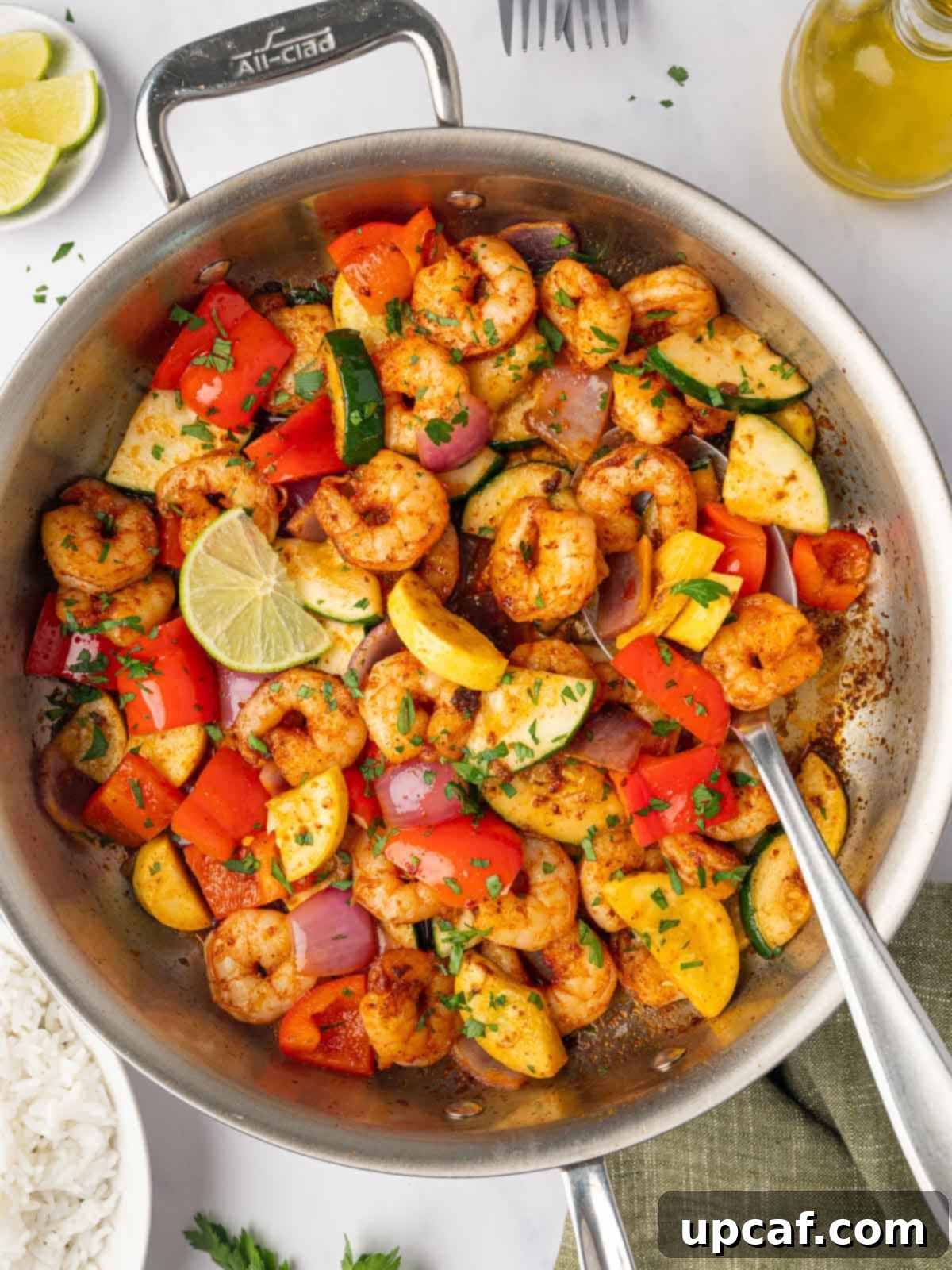
Whether you prefer a hint of spice or a milder profile, this versatile shrimp and vegetable skillet can be easily customized to your taste. Its simplicity makes it a fantastic option for meal prepping, ensuring you have healthy, homemade meals ready to go throughout your busy week. Say goodbye to dull dinners and embrace a dish that brings vibrant flavors and wholesome ingredients to your table with minimal effort.
If you’re looking for more quick and delightful seafood options, be sure to explore other favorites like the Teriyaki Salmon Stir Fry, a flavorful Easy Greek Salmon Recipe, or the ever-popular Spicy Honey Garlic Salmon. Each recipe promises a fantastic culinary experience!
Why This Shrimp and Vegetable Skillet Will Become Your Go-To Recipe
This shrimp and vegetable skillet isn’t just another dinner idea; it’s a culinary staple waiting to happen in your kitchen. Here’s why you’ll find yourself returning to this recipe time and time again:
- Effortlessly Versatile: One of the standout features of this dish is its incredible adaptability. Don’t like a certain vegetable? Simply swap it out for another! Have an abundance of seasonal produce? Incorporate it! Beyond vegetables, you can easily substitute shrimp with other proteins like chicken breast or even tofu for a delicious vegetarian alternative, making it a truly customizable meal for any preference or dietary need.
- Bursting with Flavor: Despite its quick preparation, this recipe delivers an explosion of taste. The simple yet potent marinade infuses the shrimp with deep, aromatic flavors that perfectly complement the freshness of the vegetables. Each bite offers a harmonious blend of savory, tangy, and subtly spicy notes, guaranteeing a meal that satisfies and leaves you craving more.
- Nutritious, Wholesome, and Quick: In today’s fast-paced world, finding meals that are both healthy and easy to make is a golden ticket. This skillet dinner ticks all the boxes. Packed with lean protein from the shrimp and a rainbow of vitamins and minerals from fresh vegetables, it’s a powerhouse of nutrition. Best of all, it’s on your table in under 30 minutes, proving that healthy eating doesn’t require hours in the kitchen.
- Perfect for Meal Prep: Planning ahead is crucial for maintaining a healthy lifestyle, and this recipe excels in that department. It stores beautifully, making it an ideal candidate for your weekly meal prep. Cook a larger batch on the weekend, and enjoy flavorful, balanced meals throughout your busy weekdays.
- Family-Friendly Appeal: With its bright colors and appealing flavors, this shrimp and vegetable skillet is often a hit with the entire family. Its mild base can be easily spiced up for adult palates while remaining palatable for younger eaters, ensuring everyone enjoys a wholesome and delicious meal together.
Essential Ingredients for Your Skillet Creation
Crafting this delightful shrimp and vegetable skillet starts with selecting quality ingredients. Here’s a detailed look at what you’ll need to bring this flavorful dish to life:
- Premium Shrimp: The star of our dish! Aim for raw, large or jumbo-sized shrimp for the best texture and flavor. Whether frozen or fresh, ensure they are peeled and deveined. While tails-off is often preferred for convenience, feel free to remove them yourself if they come with tails on. The larger size of the shrimp provides a satisfying bite and prevents overcooking, resulting in wonderfully tender seafood.
- A Colorful Array of Mixed Vegetables: For this recipe, we’ve chosen a fantastic combination of zucchini, yellow squash, bell peppers (any color, though red adds a beautiful sweetness), and red onion. This selection not only provides a diverse nutritional profile but also ensures even cooking due to similar densities. These vegetables become delightfully tender-crisp, absorbing the marinade’s flavors beautifully.
- The Perfect Blend of Spices: A simple yet powerful spice blend elevates this dish. You’ll need staple spices like black pepper, salt, cumin powder, and paprika. We also incorporate a touch of chili seasoning – this refers to the mild, savory seasoning blend typically used for chili dishes, not fiery hot chili powder. This combination provides warmth and depth without overwhelming the natural flavors of the shrimp and vegetables.
- Fresh Garlic and Zesty Lime: These two ingredients are non-negotiable for boosting the overall flavor profile. Freshly minced garlic provides an aromatic foundation, while fresh lime juice adds a bright, tangy acidity that cuts through the richness and enhances every ingredient. Always opt for fresh garlic cloves and squeezed lime juice over their jarred or bottled counterparts for a truly vibrant taste.
- Quality Olive Oil: A light-tasting olive oil is essential for sautéing and in the marinade. It helps to conduct heat evenly, prevents sticking, and adds a subtle, healthy fat component to the dish.
Creative Ingredient Variations and Substitutions
This recipe is incredibly flexible, allowing you to tailor it to your dietary preferences, what you have on hand, or simply what you’re craving. Don’t hesitate to get creative!
- Shrimp Alternatives: If shrimp isn’t available or you’re looking for a different protein, boneless, skinless chicken breast or chicken thighs are excellent substitutes. Simply cut them into bite-sized pieces and adjust the cooking time until they are thoroughly cooked. For a fantastic vegetarian or vegan option, firm tofu, pressed and cubed, works wonderfully, absorbing the marinade flavors beautifully.
- Expand Your Vegetable Horizons: The beauty of a skillet meal is its adaptability to various vegetables. Feel free to incorporate or swap out any of your favorites. Great additions include broccoli florets, tender asparagus spears, crisp snap peas, sliced mushrooms, green beans, or even small chunks of sweet potato for added heartiness. Remember to cut vegetables into similar sizes to ensure they cook evenly.
- Experiment with Spices: While our basic spice blend is delicious, don’t shy away from exploring other flavor profiles. For a kick of Southern flair, a dash of Cajun seasoning can transform the dish. Italian herbs like oregano, basil, and thyme will lend a Mediterranean touch. If you truly love heat, a pinch of red pepper flakes added to the marinade or while sautéing will deliver that extra zing. A hint of smoked paprika can also add a delightful smoky depth.
- Alternative Citrus: If fresh lime isn’t available, lemon juice can be used as a worthy substitute, offering a similar bright acidity to the marinade.
Step-by-Step Guide: How to Craft Your Perfect Shrimp and Vegetable Skillet
Creating this flavorful and healthy skillet meal is straightforward and quick. Follow these simple steps for a truly delicious result:

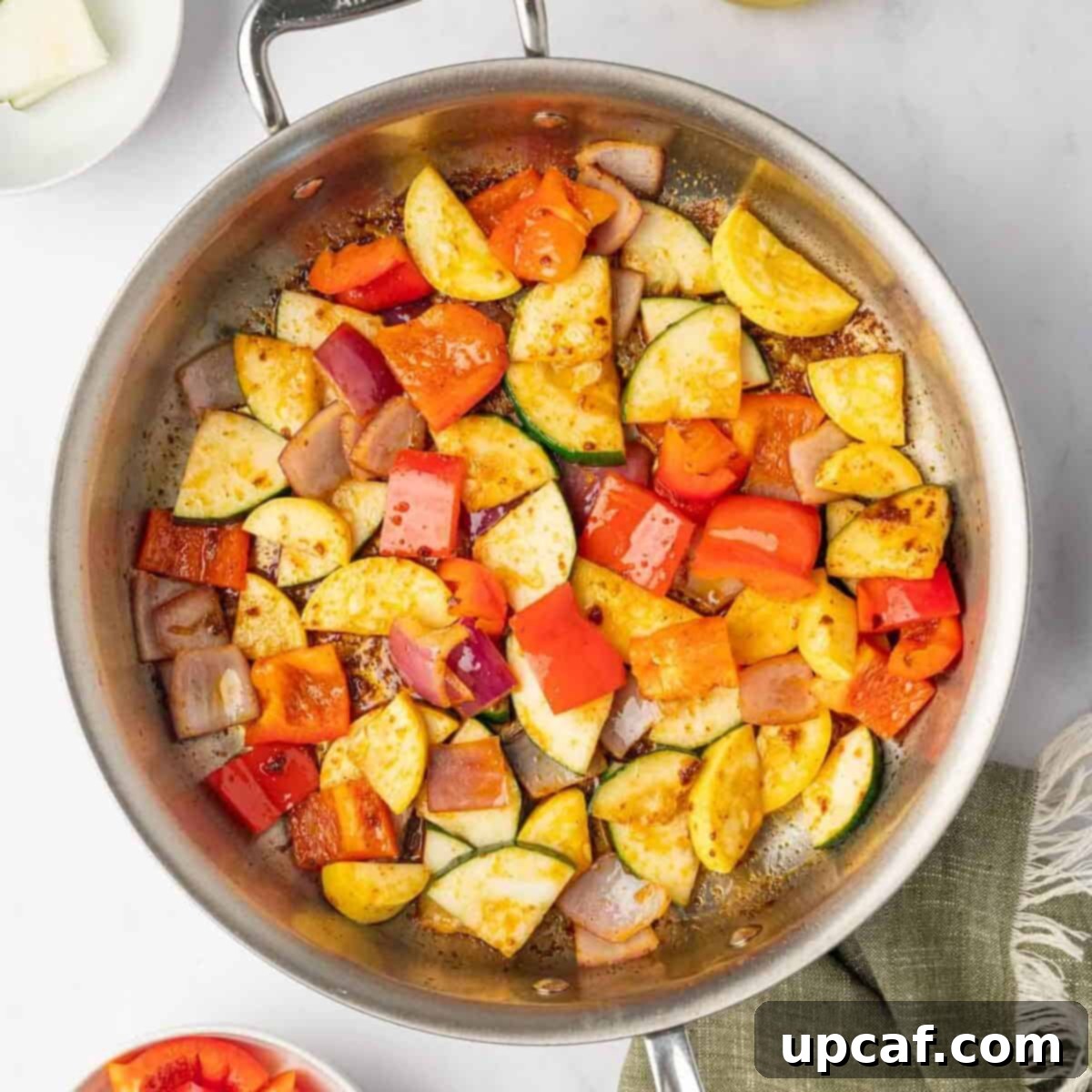
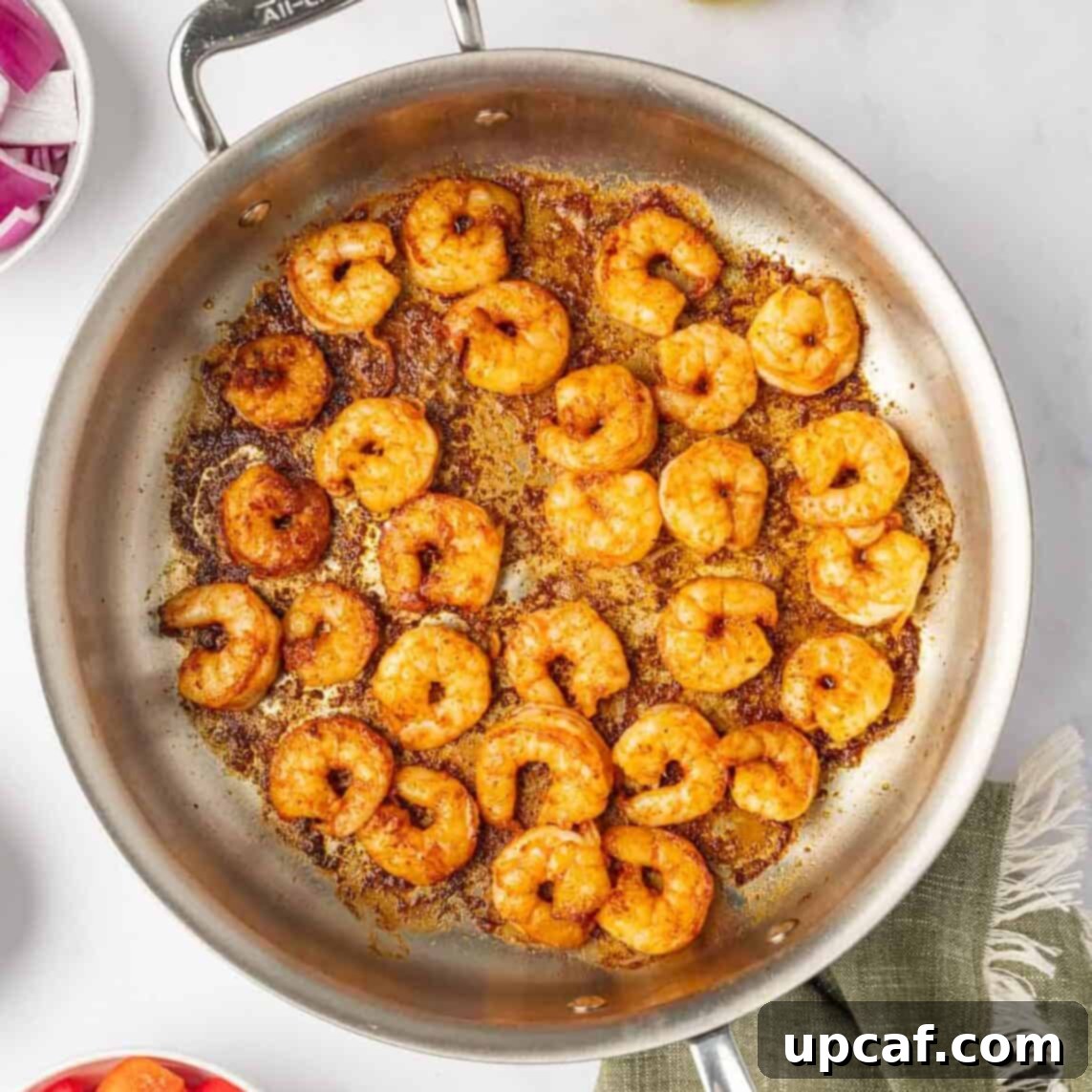
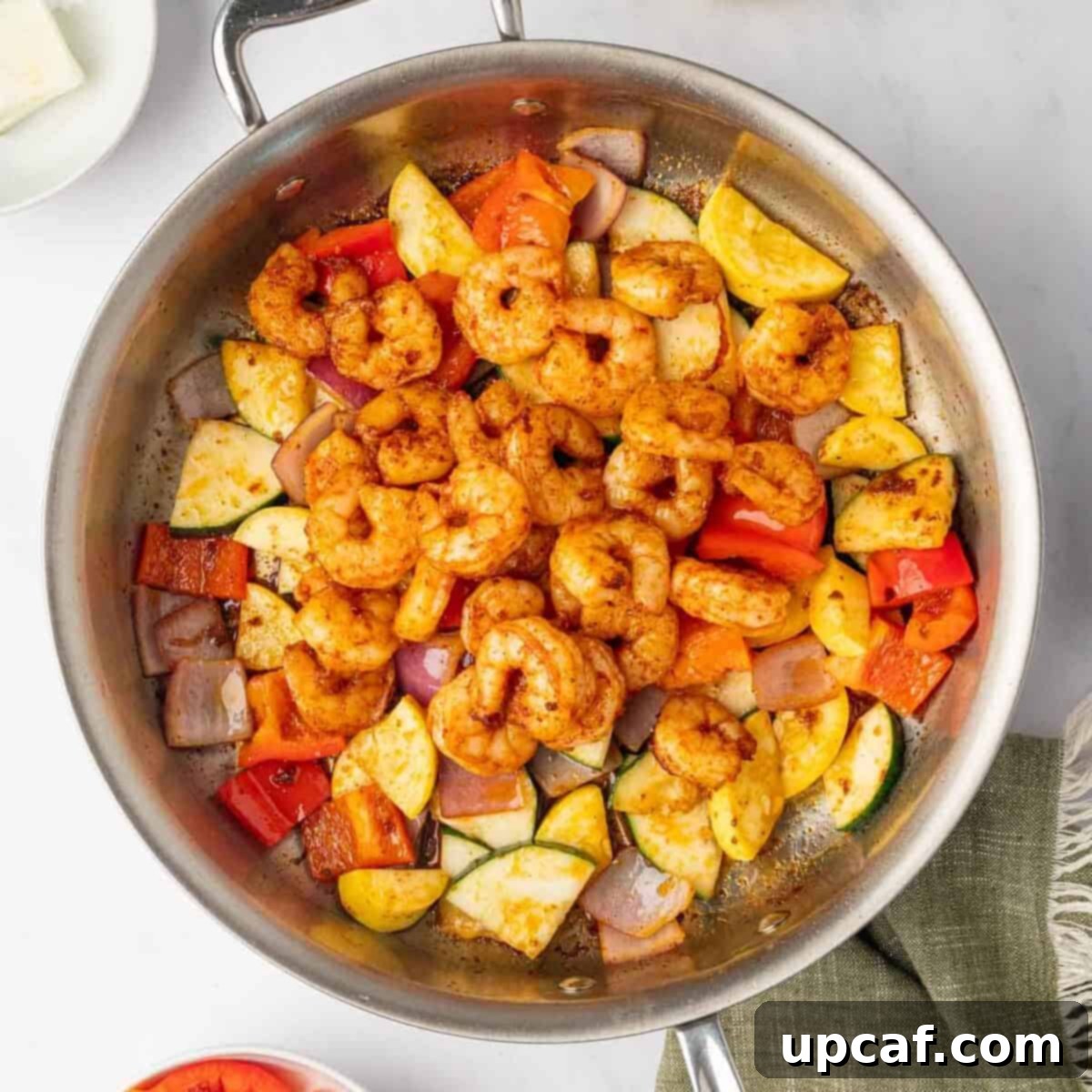
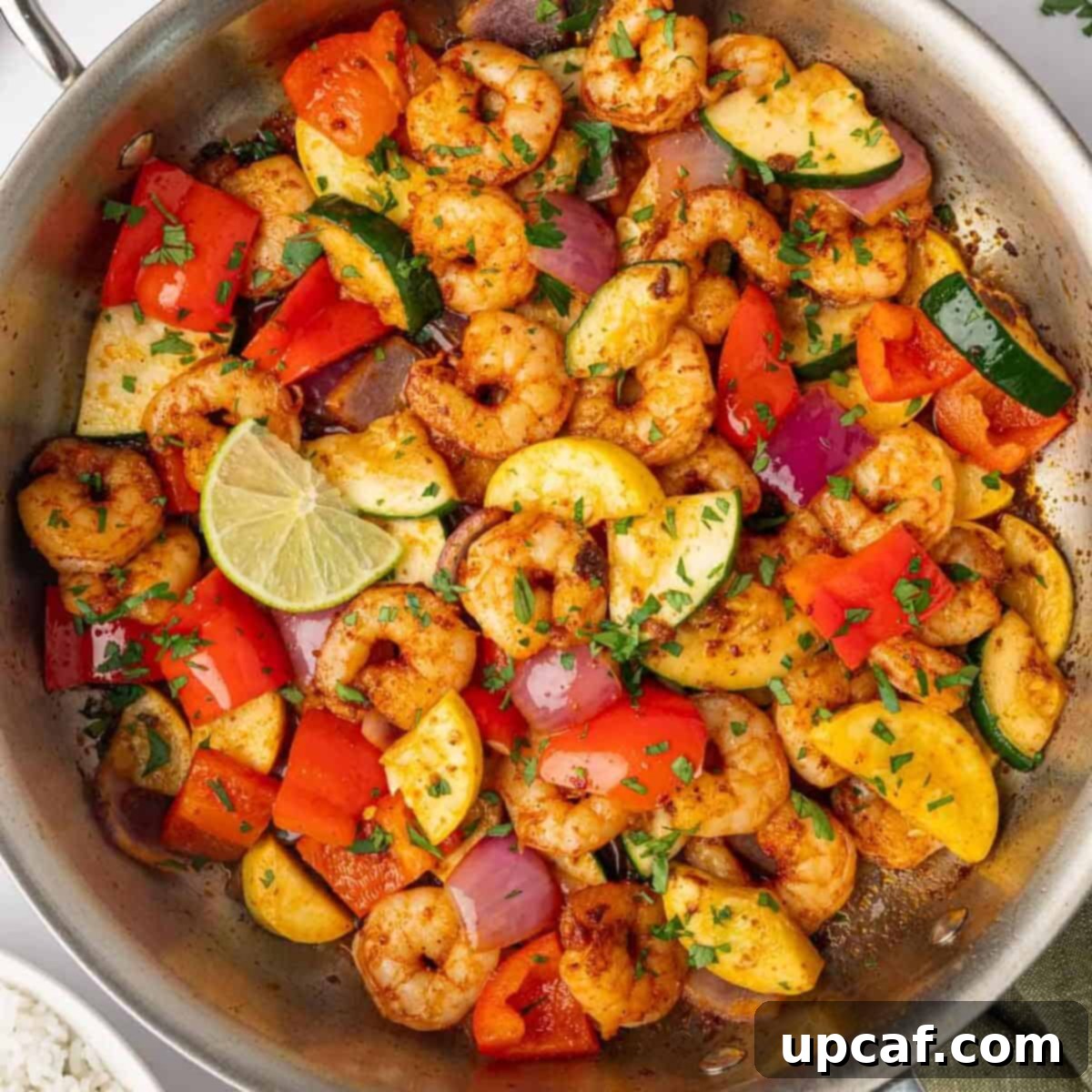
Expert Tips to Master This Skillet Recipe
Achieving a restaurant-quality shrimp and vegetable skillet at home is easier than you think with these expert tips:
- Thoroughly Pat Dry the Shrimp: This is a crucial step! Excess moisture on the shrimp will steam them instead of allowing them to sear properly, preventing that desirable golden-brown crust and juicy interior. Use paper towels to pat them as dry as possible before marinating.
- Avoid Overcooking the Shrimp: Shrimp cook very quickly. As soon as they turn opaque and pink and curl into a “C” shape, they are done. Overcooked shrimp become tough, rubbery, and lose their delicate flavor. Keep a close eye on them during sautéing.
- Don’t Overcook the Vegetables: For optimal texture, aim for tender-crisp vegetables. They should still have a slight bite and retain their vibrant color, not be mushy. This ensures a delightful contrast with the tender shrimp.
- Marination Time Matters: While a quick toss in the marinade works in a pinch, allowing the shrimp to marinate for at least 20-30 minutes (or even up to an hour in the refrigerator) will infuse them with significantly more flavor, making the dish truly exceptional.
- Choose the Right Shrimp Size: Medium to large shrimp (typically 16/20 or 21/25 count per pound) are ideal for this skillet. They are substantial enough to hold up during cooking without shrinking too much and remain wonderfully juicy. Smaller shrimp can overcook very quickly.
- Uniform Vegetable Cuts: Ensure all your vegetables are cut into roughly the same size and shape. This guarantees that they will cook evenly and reach that perfect tender-crisp consistency at the same time.
- Use a Hot Skillet: A properly preheated skillet is key to achieving a good sear on both the shrimp and vegetables. Don’t add ingredients until the olive oil is shimmering.
- Don’t Crowd the Pan: Cook the shrimp and vegetables in batches if necessary. Crowding the skillet lowers the temperature, leading to steaming instead of searing, which results in less flavorful, less appealing textures.
- Fresh Ingredients are Best: For the most vibrant flavors, always opt for fresh garlic, fresh lime juice, and fresh vegetables over pre-chopped, jarred, or frozen alternatives.
Understanding Shrimp: A Culinary Delight
Shrimp, those delectable underwater crustaceans, are far more than just a tasty meal. They are a globally cherished type of seafood, revered for their versatility, quick cooking time, and impressive nutritional profile. Packed with lean protein, they are a fantastic option for those seeking low-carb and low-calorie food sources that don’t skimp on flavor. Beyond protein, shrimp provide a wealth of essential nutrients, including selenium, vitamin B12, phosphorus, niacin, and choline, all contributing to overall health and well-being. Their delicate, slightly sweet flavor and firm yet tender texture make them a favorite ingredient in cuisines worldwide, from quick weeknight stir-fries to elegant gourmet dishes.
Decoding Shrimp Sizes for Your Recipes
Navigating the world of shrimp sizes can sometimes be confusing, but it’s essential for achieving the best results in your cooking. When purchasing shrimp, you’ll often notice a count per pound listed on the packaging, such as “16/20” or “31/40.” This number indicates how many individual shrimp are in one pound. A lower count signifies larger shrimp, while a higher count means smaller shrimp. For dishes like this skillet where you want substantial, juicy pieces that don’t overcook easily, I highly recommend using large (31/35 count) or jumbo (16/20 count) shrimp. These sizes offer a more satisfying texture and retain moisture better during sautéing, ensuring every bite is succulent and full of flavor. Smaller shrimp, while great for salads or quick additions, can cook too quickly and become rubbery in a skillet application.
Shrimp vs. Prawns: Unraveling the Confusion
The terms “shrimp” and “prawns” are often used interchangeably, leading many to believe they are one and the same. While closely related and sharing many culinary similarities, these two crustaceans do have distinct biological differences. Prawns are typically larger than shrimp and possess a different anatomical structure; for instance, prawns have branching gills, while shrimp have lamellar gills. A key visual difference lies in their abdominal segments: shrimp have overlapping segments, where each segment overlaps the one behind it, creating a distinctive bend. Prawns, conversely, have segments that overlap in sequence, making them appear straighter and less curled. Despite these differences, their flavor and nutritional values are remarkably similar, making them largely interchangeable in most recipes. So, if you find prawns instead of shrimp, feel confident using them in this skillet recipe – you’ll still get a delicious result!
Raw vs. Cooked Shrimp: A Chef’s Perspective
When selecting shrimp for cooking, you’ll often encounter both raw (grey) and pre-cooked (pink) options. While pre-cooked shrimp offer ultimate convenience, they require very little, if any, additional cooking time and are often used in cold dishes like salads or shrimp cocktails. My strong preference for recipes that involve cooking, such as this skillet, is raw shrimp. Raw shrimp provide a greater degree of control over the cooking process, allowing you to achieve a perfectly tender, juicy texture that is less likely to become chewy or rubbery. When pre-cooked shrimp are reheated or cooked further, they tend to dry out quickly and develop an unappealing, tough consistency. Starting with raw shrimp ensures that they absorb the marinade’s flavors more effectively and finish with an incomparably succulent result that truly elevates the dish.
Perfect Pairings: What to Serve with Your Skillet Creation
The beauty of this Shrimp and Vegetable Skillet lies in its versatility, making it a fantastic main course that pairs wonderfully with a variety of sides. Here are some of my favorite recommendations to complete your meal:
- Fluffy Grains: A classic pairing, serving the shrimp and vegetables over a bed of light, fluffy white rice or nutrient-rich quinoa provides a comforting and absorbent base for all the delicious flavors. For an extra layer of taste, consider my Easy Mexican Fried Rice recipe, which offers a delightful complementary flavor profile. Brown rice or couscous are also excellent healthy options.
- Hearty Pasta: For a more substantial and comforting meal, toss the cooked shrimp and vegetables with your favorite pasta. A drizzle of extra olive oil, a splash of the shrimp marinade, or a light sauce can bring the dish together beautifully. This combination transforms the skillet into a hearty pasta dish that’s both satisfying and flavorful. You might even love it with my unique Creamy Gochujang Pasta for an unexpected twist.
- Crisp Green Salad: To keep the meal light and refreshing, a simple green salad with a vibrant vinaigrette makes an ideal accompaniment. The crispness of fresh greens offers a wonderful textural contrast to the tender shrimp and vegetables. My Delicious and Simple House Salad recipe would be a perfect match, providing a clean and bright counterpoint to the rich skillet flavors.
- Cauliflower Rice: For those following a strict low-carb diet, cauliflower rice is an excellent substitute for traditional grains. It absorbs the flavors beautifully and adds extra vegetable goodness without the carbohydrates.
- Crusty Bread: A warm, crusty baguette or artisanal bread is perfect for soaking up any delicious juices left in the skillet, adding a satisfying element to your meal.
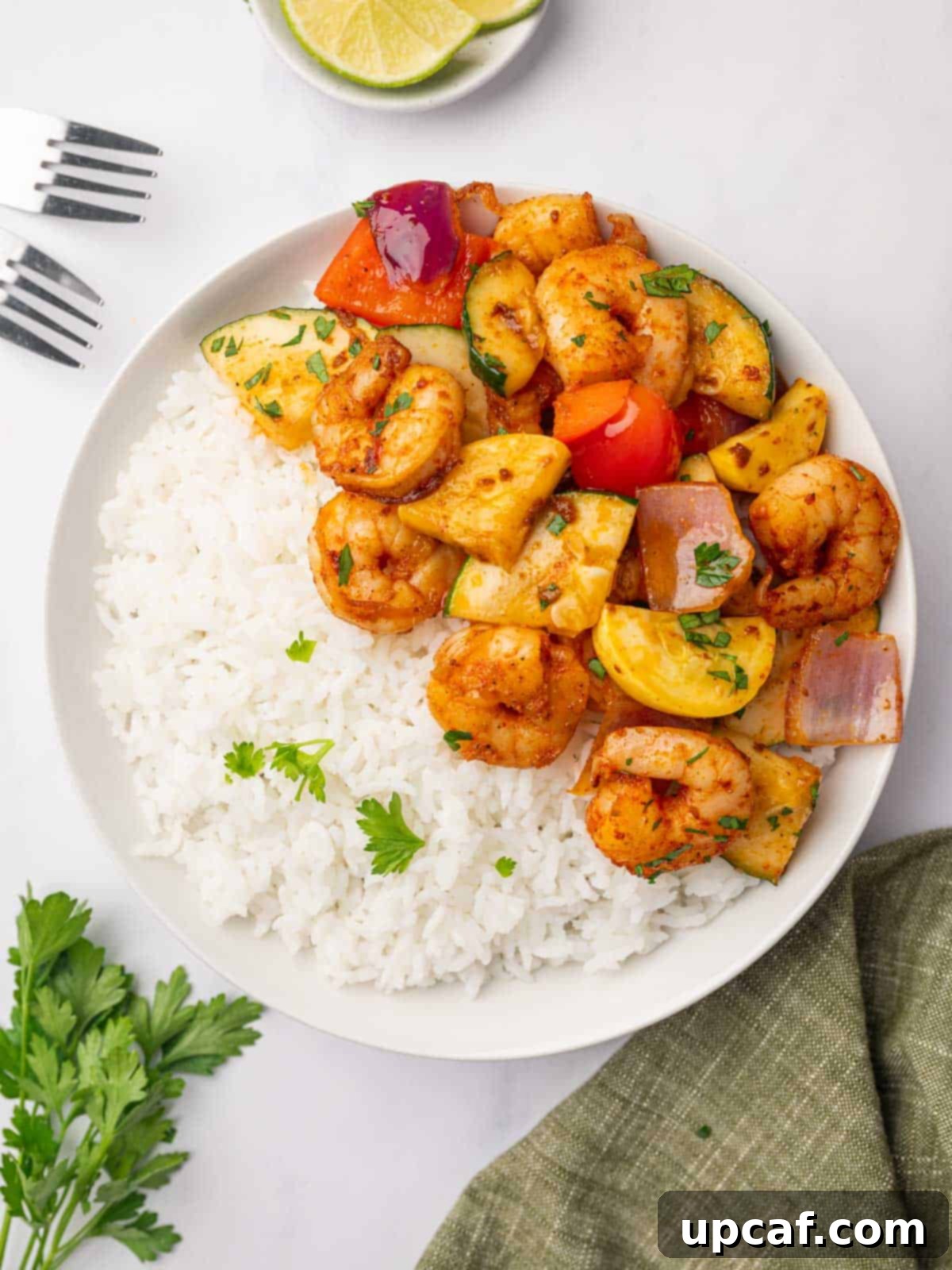
Frequently Asked Questions About Shrimp and Vegetable Skillet
Here are answers to some common questions about preparing and enjoying your shrimp and vegetable skillet:
No, shrimp are not classified as fish. Fish are vertebrates, meaning they possess an internal skeleton. Shrimp, on the other hand, are invertebrates with an external skeleton or carapace, placing them in the category of shellfish, specifically crustaceans.
Cooked shrimp will undergo a noticeable transformation: they turn from translucent grey to opaque pink, and their bodies will curl into a characteristic “C” shape. It’s crucial not to overcook them, as this will result in a tough, rubbery texture. Cooking typically takes only 2-3 minutes per side on high heat.
While often confused and used interchangeably in culinary contexts, shrimp and prawns are distinct. They differ in their anatomy, particularly their gill structure and how their abdominal segments overlap. Prawns tend to be larger and have three pairs of claw-like legs, while shrimp have one. Despite their differences, their flavor and nutritional profile are very similar, allowing them to be substituted for one another in most recipes.
For reheating, the best method is to gently warm the leftovers in a skillet over medium heat until they are thoroughly heated through. This helps maintain the texture of both the shrimp and vegetables. Avoid using a microwave if possible, as it tends to make shrimp rubbery. To store, place any leftover skillet meal in an airtight container and refrigerate for up to two days for optimal freshness and safety.
This shrimp and vegetable skillet is undeniably best enjoyed immediately after cooking for peak flavor and texture. However, you can certainly prep many of the ingredients ahead of time. You can chop all your vegetables and store them in the refrigerator, and even mix the marinade ingredients. Cooked leftovers can be safely stored in an airtight container in the refrigerator for up to 2 days, making it a great option for future meals.

The Wholesome Goodness: Health Benefits of This Skillet
Beyond its incredible taste and ease of preparation, this Shrimp and Vegetable Skillet is a powerhouse of nutrition, making it an excellent choice for a health-conscious lifestyle. Here’s a breakdown of the fantastic health benefits you’ll reap from this delicious meal:
- High-Quality Lean Protein: Shrimp are an excellent source of high-quality protein, which is vital for muscle repair, growth, and overall body function. Protein also helps keep you feeling full and satisfied, aiding in weight management.
- Rich in Vitamins and Minerals: The combination of shrimp and a variety of vegetables provides a broad spectrum of essential vitamins and minerals. Shrimp are particularly rich in selenium, an important antioxidant, as well as B vitamins (B12, niacin), phosphorus, and iodine. The colorful vegetables add vitamins A and C, potassium, and dietary fiber.
- Low in Calories and Carbohydrates: This skillet meal is naturally low in calories and carbohydrates, making it an ideal choice for those following ketogenic, paleo, or general low-carb diets. It allows you to enjoy a flavorful, filling meal without excessive caloric intake.
- Heart-Healthy Omega-3s: While not as high as fatty fish like salmon, shrimp do contain some beneficial omega-3 fatty acids, which are known to support cardiovascular health and reduce inflammation.
- Antioxidant Boost: Many of the spices used, like paprika and cumin, along with the fresh vegetables, are rich in antioxidants. These compounds help combat free radicals in the body, protecting cells from damage and promoting long-term health.
- Digestive Health: The fiber from the fresh vegetables contributes to healthy digestion and can help prevent constipation, supporting a robust gut microbiome.
- Supports Immune Function: The array of nutrients, particularly vitamins C and A from the vegetables and selenium from shrimp, plays a crucial role in bolstering your immune system, helping your body defend against illness.
Incorporating this Shrimp and Vegetable Skillet into your meal rotation is a simple yet effective way to enjoy a balanced, nutrient-dense diet without sacrificing taste or convenience.
Discover More Delicious Shrimp Recipes
If you’ve enjoyed this quick and flavorful skillet, you’ll love exploring these other fantastic shrimp recipes from our collection:
- Quick & Easy Air Fryer Shrimp and Veggies
- Refreshing Shrimp Orzo Salad
- Simple and Flavorful Grilled Garlic Shrimp
The Shrimp and Vegetable Skillet is truly a versatile, flavorful, and healthy recipe that deserves a permanent spot in your kitchen repertoire. With its quick cooking time, wholesome ingredients, and endless customization possibilities, it’s no wonder this dish is a favorite among home cooks looking for efficient and delicious meal solutions. Give it a try, and prepare to be amazed by how much flavor you can create in so little time!
If you try this recipe or any of my other culinary creations, please consider leaving a star rating and a comment in the section below. Your feedback is invaluable! Also, connect with me at Cookin’ With Mima on Facebook | Instagram | Pinterest for all my latest social posts, kitchen tips, and delicious new recipes.
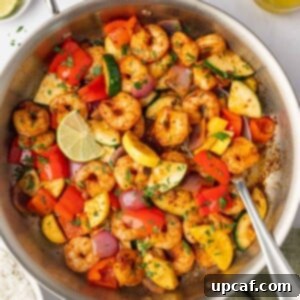
Shrimp and Vegetables Skillet
Mariam Ezzeddine
10 minutes
10 minutes
20 minutes
4 servings
Ingredients
- 2 lbs. large shrimp, raw, peeled, deveined and tails off
- 1 tbsp. olive oil, light tasting
- Chopped parsley, optional for garnishing
Marinade
- 3 tbsps. lime juice
- 1 tsp. salt
- 2 tsps. fresh ground black pepper
- 1 tbsp. chili seasoning, the actual beef chili seasoning, not hot chili pepper
- 1 tsp. paprika
- ½ tsps. cumin
- 2 cloves fresh garlic, minced
- 1 tbsp. olive oil, light tasting
Veggies
- 1 small purple onion, diced
- 1 large zucchini, halved and sliced
- 1 large yellow squash, halved and sliced
- 1 large red bell pepper, cubed
- 1 tbsp. olive oil, light tasting
Instructions
- Pat the shrimp dry with paper towel and place into a bowl. Add in the marinade ingredients and mix well to coat the shrimp. Set aside to marinate for at least 10-15 minutes, or up to 30 minutes if time permits.
- To prepare the veggies, wash and dry them well. Chop or cube them into uniform, bite-sized pieces.
- In a large non-stick skillet, add one tablespoon of olive oil and heat over medium-high. Sauté the chopped vegetables until they are tender-crisp and begin to obtain a golden color, about 5-7 minutes. Remove the cooked vegetables and set aside in a bowl.
- Using the same skillet, add another tablespoon of olive oil and increase to high heat. Sauté the marinated shrimp until they are fully cooked through, turning pink and opaque and curling into a “C” shape. This usually takes about 6-8 minutes total, flipping the shrimp pieces over halfway through. Be careful not to overcook them.
- Return the cooked vegetables back into the skillet with the shrimp. Toss everything together gently and sauté for another 1-2 minutes to combine the flavors and warm the vegetables.
- Remove from heat and serve immediately. Garnish with fresh chopped parsley and lime wedges if desired.
Video
A video tutorial for this recipe is available!
Notes
- For the best texture, opt for raw shrimp (even if frozen) over pre-cooked frozen shrimp, which can become chewy.
- Large or jumbo-sized shrimp are recommended for the most flavor and satisfying bite.
- Always use fresh vegetables for optimal taste, texture, and nutritional value.
- While marinating the shrimp for up to 30 minutes enhances flavor, it’s not strictly essential if you’re short on time.
- Cut your vegetables into similar sizes to ensure they cook evenly and consistently.
- Excellent additional veggie choices include broccoli, asparagus, mushrooms, and sugar snap peas.
- For an extra layer of heat and zest, a pinch of red pepper flakes can be added to the marinade or during cooking.
Nutrition
Calories: 333kcal |
Carbohydrates: 11.1g |
Protein: 47.3g |
Fat: 12.3g |
Saturated Fat: 2.8g |
Sodium: 913.8mg |
Sugar: 4.3g
Like this recipe? Rate and comment below!
